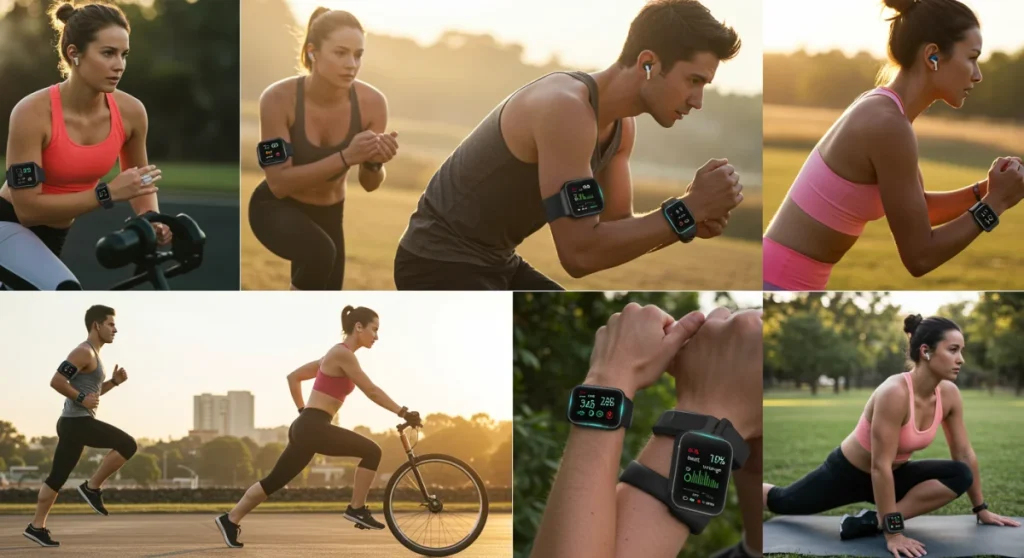Wearable Tech for 2025 Fitness: Elevate Your Routine

Wearable technology will significantly enhance 2025 fitness routines by providing real-time data, personalized coaching, and comprehensive health insights, empowering users to achieve their wellness goals more efficiently.
As we approach 2025, the integration of technology into our daily lives continues to accelerate, and nowhere is this more evident than in the realm of fitness. The role of wearable technology in elevating your 2025 fitness routine: a practical guide to 4 key devices is becoming increasingly central, transforming how we track our progress, understand our bodies, and achieve our health goals. These sophisticated gadgets are no longer just step counters; they are intelligent companions offering unparalleled insights.
The evolving landscape of wearable fitness technology
The fitness industry is undergoing a profound transformation, driven largely by advancements in wearable technology. What began with simple pedometers has blossomed into a sophisticated ecosystem of devices capable of monitoring a vast array of physiological metrics. This evolution promises a future where our fitness routines are not just guided, but truly optimized by data.
In 2025, wearable devices are expected to move beyond basic tracking, offering predictive analytics and hyper-personalized recommendations. They will increasingly integrate with AI-driven platforms, providing actionable insights that adapt to our individual progress and challenges. This shift from passive data collection to active, intelligent guidance is what truly sets the next generation of wearables apart.
Beyond basic tracking: advanced metrics and insights
- Heart Rate Variability (HRV): Measuring the variation in time between heartbeats to assess recovery and stress levels.
- Blood Oxygen Saturation (SpO2): Monitoring oxygen levels, crucial for understanding respiratory health and sleep quality.
- Skin Temperature: Detecting subtle changes that can indicate illness, stress, or even menstrual cycle phases.
- Electrodermal Activity (EDA): Sensing changes in sweat gland activity to quantify stress responses.
The ability to track these advanced metrics provides a holistic view of our health, far beyond just calories burned or steps taken. This comprehensive data allows for a more nuanced understanding of our body’s responses to exercise, stress, and sleep, enabling us to make more informed decisions about our fitness and well-being. The interpretation of this data is key to unlocking personalized fitness strategies.
Furthermore, the integration of these metrics into user-friendly interfaces ensures that complex biological data is accessible and understandable to the average user. This democratizes health insights, allowing everyone to take a more proactive role in managing their physical and mental health. The future of fitness is not just about working out harder, but working out smarter, guided by precise, personal data.
Smartwatches: your ultimate wrist-worn fitness coach
Smartwatches have firmly established themselves as indispensable tools for fitness enthusiasts, and their capabilities are only expanding. In 2025, these devices will serve as comprehensive fitness hubs, offering a seamless blend of activity tracking, health monitoring, and smart notifications, all from your wrist. They are designed to integrate effortlessly into your daily life, making health and fitness a constant, manageable priority.
The latest smartwatches are equipped with advanced sensors that go far beyond step counting. They offer precise GPS tracking for outdoor activities, continuous heart rate monitoring, and even ECG capabilities to detect potential heart rhythm irregularities. This makes them not just workout companions, but vital health monitoring devices, providing peace of mind alongside performance data.
Key features enhancing your fitness routine
- Personalized Workout Suggestions: AI-driven algorithms analyze your performance data and suggest workouts tailored to your goals and recovery status.
- Advanced Sleep Tracking: Detailed insights into sleep stages, duration, and quality, helping you optimize recovery.
- Stress Monitoring & Guided Breathing: Tools to help manage stress throughout the day, vital for overall well-being.
- NFC Payments & Music Control: Convenience features that allow you to leave your phone behind during workouts.
The integration of these features means that smartwatches are evolving into true personal coaches. They provide real-time feedback during workouts, motivate you to stay active, and even nudge you towards better recovery practices. This holistic approach ensures that every aspect of your fitness journey is supported and optimized, making your goals more attainable and your progress more consistent.
Furthermore, the ability to receive notifications and manage calls without breaking stride adds a layer of convenience that is invaluable for busy individuals. Smartwatches are not just about tracking; they are about streamlining your life to prioritize health. This blend of functionality and convenience cements their position as a cornerstone of the 2025 fitness routine, making them an essential device for anyone serious about their health.
Fitness rings: subtle powerhouses for continuous health monitoring
In contrast to the more overt presence of smartwatches, fitness rings offer a discreet yet powerful alternative for continuous health monitoring. These minimalist devices, worn on a finger, pack an impressive array of sensors into a sleek, unobtrusive design. For those who prefer to track their health without a screen constantly vying for attention, fitness rings present an ideal solution, blending seamlessly into everyday wear.
Fitness rings excel at providing long-term, passive data collection, making them particularly effective for sleep tracking and recovery analysis. Because they are less noticeable and often more comfortable to wear overnight than smartwatches, they can capture more consistent and accurate sleep data. This makes them invaluable for understanding your body’s recovery patterns and optimizing your rest.
Advantages of incorporating a fitness ring
- Unobtrusive Design: Ideal for continuous wear, including during sleep and formal occasions.
- Exceptional Battery Life: Often lasting several days on a single charge, minimizing charging interruptions.
- Accurate Sleep Tracking: Provides detailed insights into sleep stages, duration, and disturbances.
- Recovery Insights: Monitors HRV and body temperature to assess readiness for training and overall well-being.
The focus on recovery and sleep makes fitness rings a powerful complement to other fitness devices. While a smartwatch might guide your workout, a fitness ring can tell you if your body is truly ready for that workout, or if you need more rest. This synergy allows for a more intelligent and sustainable approach to fitness, preventing overtraining and promoting optimal performance.
Moreover, the subtle nature of fitness rings means they can be worn by individuals who might find smartwatches too bulky or distracting. Their focus on core health metrics, combined with their elegant design, positions them as a growing trend in wearable technology. As we move into 2025, their ability to provide continuous, high-quality data without demanding constant interaction will be highly valued by a wide range of users.
Smart apparel and sensors: integrating data directly into your gear
The next frontier in wearable technology is smart apparel and embedded sensors. Imagine your workout clothes not just wicking away sweat, but also continuously monitoring your biometrics, analyzing your form, and providing real-time feedback. This integration of technology directly into clothing and accessories promises a truly seamless and insightful fitness experience, removing the need for separate devices.
Smart apparel can track everything from muscle activity and posture to heart rate and respiration, all without you having to remember to put on a gadget. This level of integration makes data collection effortless and ensures that critical metrics are captured consistently, even during the most intense workouts. The subtlety of these sensors means they won’t interfere with your movement or comfort.
![]()
Revolutionizing training with smart textiles
- Form Analysis: Sensors embedded in leggings or tops can detect imbalances or incorrect form, preventing injuries.
- Muscle Activation Tracking: Providing data on which muscle groups are working hardest, optimizing strength training.
- Biometric Shirts: Continuously monitoring heart rate, breathing rate, and skin temperature with medical-grade accuracy.
- Smart Shoes: Analyzing gait, stride length, and impact forces to improve running efficiency and reduce injury risk.
The potential for smart apparel to revolutionize training is immense. By providing immediate feedback on form and muscle activation, athletes can refine their technique in real-time, leading to more effective workouts and a reduced risk of injury. This goes beyond what traditional wearables can offer, moving into the realm of biomechanical analysis.
Furthermore, for those involved in team sports or rehabilitation, smart apparel can provide coaches and physical therapists with invaluable data on performance and recovery. This detailed information allows for highly personalized training plans and targeted interventions, accelerating progress and improving outcomes. The future of fitness gear is not just about comfort and performance, but also about intelligence and data-driven improvement.
Continuous glucose monitors (CGMs): optimizing nutrition and energy levels
While traditionally associated with diabetes management, Continuous Glucose Monitors (CGMs) are rapidly gaining traction in the general fitness community as a powerful tool for optimizing nutrition and energy levels. By providing real-time data on blood glucose fluctuations, CGMs offer unprecedented insight into how different foods and activities impact your body’s energy regulation. This information is invaluable for anyone looking to fine-tune their diet for peak performance and sustained energy.
Understanding your glucose response allows you to identify which foods cause spikes and crashes, and how your body reacts to workouts. This personalized data enables you to make informed decisions about meal timing, carbohydrate intake, and snack choices, leading to more stable energy levels throughout the day and improved workout performance. It’s a game-changer for personalized nutrition.
How CGMs enhance fitness and diet
- Personalized Dietary Insights: See how specific foods affect your blood sugar, helping you identify optimal nutrition for your body.
- Energy Level Management: Avoid energy crashes by understanding and managing glucose spikes and dips.
- Optimized Pre/Post-Workout Nutrition: Fine-tune your fuel intake to maximize performance and recovery.
- Metabolic Health Tracking: Gain a deeper understanding of your body’s metabolic responses to lifestyle choices.
The real-time feedback from CGMs empowers individuals to move beyond generic dietary advice and discover what truly works for their unique physiology. This level of personalization is crucial for athletes seeking to optimize their performance and for anyone aiming to improve their overall metabolic health and energy. It transforms eating from a guessing game into a data-driven strategy.
As CGMs become more accessible and integrated with other fitness platforms, their role in mainstream fitness is set to expand significantly by 2025. They offer a concrete, measurable way to connect diet with performance and well-being, providing a missing piece of the puzzle for many fitness enthusiasts. This innovative technology promises to unlock new levels of dietary precision and energy optimization.
Integrating wearables for a holistic fitness approach
The true power of wearable technology in 2025 lies not just in individual devices, but in their synergistic integration. A holistic fitness approach leverages the strengths of various wearables, creating a comprehensive data ecosystem that provides a 360-degree view of your health and performance. This integrated strategy allows for a level of personalization and insight previously unattainable, moving beyond isolated metrics to a complete understanding of your body.
Imagine your smartwatch tracking your workout intensity, your fitness ring monitoring your sleep and recovery, smart apparel analyzing your form, and a CGM optimizing your nutrition. All this data flows into a central platform, interpreted by AI to provide actionable advice tailored specifically to you. This is the future of fitness: an intelligent, interconnected system that guides every aspect of your wellness journey.
![]()
Building your personalized wearable ecosystem
- Data Synchronization: Ensure all your devices can share data with a central app or platform for a unified view.
- AI-Driven Insights: Look for platforms that use artificial intelligence to interpret combined data and offer personalized recommendations.
- Goal Alignment: Choose devices that align with your primary fitness goals, whether it’s performance, recovery, or metabolic health.
- User-Friendly Interface: Opt for systems that present complex data in an easy-to-understand and actionable format.
The challenge and opportunity lie in selecting the right combination of devices and platforms that work together seamlessly. Compatibility and data integration will be crucial factors in building an effective wearable ecosystem. The goal is to create a system that simplifies, rather than complicates, your health management, providing clarity and direction.
By adopting this integrated approach, you can move beyond fragmented data and gain a truly holistic understanding of your body’s needs and responses. This empowers you to make smarter choices about your training, nutrition, and recovery, leading to more sustainable progress and a significantly elevated fitness routine. The future of fitness is intelligent, integrated, and intensely personal, all thanks to the power of wearable technology.
| Key Device | Primary Benefit for Fitness |
|---|---|
| Smartwatches | Comprehensive activity tracking, personalized workout suggestions, and health monitoring. |
| Fitness Rings | Discreet, continuous sleep and recovery tracking, offering deep insights into body readiness. |
| Smart Apparel/Sensors | Integrated form analysis, muscle activation tracking, and advanced biometric monitoring. |
| Continuous Glucose Monitors (CGMs) | Real-time blood glucose data for optimizing nutrition, energy levels, and metabolic health. |
Frequently asked questions about wearable fitness technology
Wearables in 2025 will use AI to analyze your unique biometric data, performance, and recovery metrics. They will provide hyper-personalized workout suggestions, dietary advice, and recovery protocols, adapting dynamically to your body’s needs and progress, ensuring optimal training and health outcomes.
Yes, fitness rings are excellent for continuous, discreet health monitoring, especially for sleep and recovery. While they lack a screen for real-time workout metrics, their comfort and extended battery life make them superior for passive data collection, often complementing a smartwatch for a holistic view.
For non-diabetic individuals, CGMs offer real-time insights into how food and exercise impact blood glucose. This allows for personalized nutrition strategies to optimize energy levels, prevent crashes, and enhance athletic performance, leading to improved metabolic health and sustained energy throughout the day.
Smart apparel embeds sensors directly into clothing to track metrics like muscle activation, posture, and form. This provides real-time feedback, helping you correct technique, prevent injuries, and optimize muscle engagement. It transforms your gear into an intelligent coach, ensuring more effective and safer workouts.
When building your ecosystem, prioritize devices that offer robust data synchronization with a central platform. Look for AI-driven insights that interpret combined data, and ensure the devices align with your specific fitness goals. User-friendly interfaces are also crucial for making complex data actionable and understandable.
Conclusion
The journey towards a healthier, more optimized self in 2025 is undeniably intertwined with the rapid advancements in wearable technology. From the comprehensive data provided by smartwatches and the discreet recovery insights from fitness rings, to the revolutionary feedback from smart apparel and the precise nutritional guidance offered by continuous glucose monitors, these devices are setting new standards for personal fitness. By embracing an integrated approach to these smart tools, individuals can unlock unparalleled insights into their bodies, transforming generic routines into highly personalized, data-driven pathways to peak performance and enduring well-being. The future of fitness is not just about physical exertion; it’s about intelligent, informed living, empowered by the incredible potential of wearable innovation.





